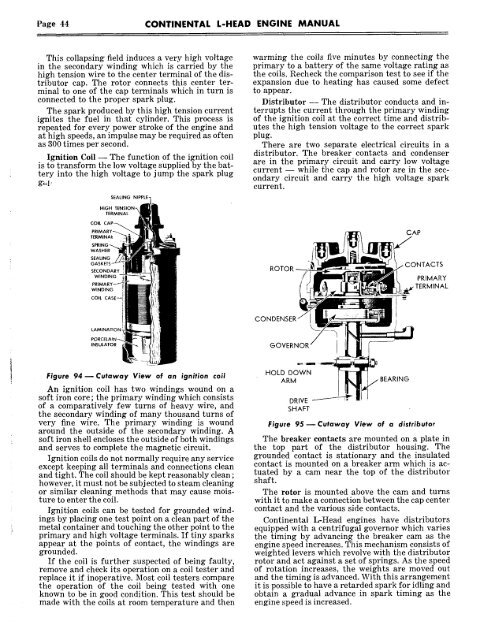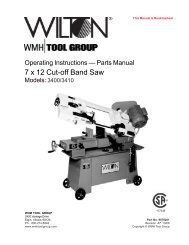Continental L-Head Overhaul Manual - Igor Chudov
Continental L-Head Overhaul Manual - Igor Chudov
Continental L-Head Overhaul Manual - Igor Chudov
You also want an ePaper? Increase the reach of your titles
YUMPU automatically turns print PDFs into web optimized ePapers that Google loves.
Page 44 CONTINENTAL L-HEAD ENGINE MANUAL<br />
This collapsing field induces a very high voltage<br />
in the secondary winding which is carried by the<br />
high tension wire to the center terminal of the distributor<br />
cap. The rotor connects this center terminal<br />
to one of the cap terminals which in turn is<br />
connected to the proper spark plug.<br />
The spark produced by this high tension current<br />
ignites the fuel in that cylinder. This process is<br />
repeated for every power stroke of the engine and<br />
at high speeds, an impulse may be required as often<br />
as 300 times per second.<br />
Ignition Coil -- The function of the ignition coil<br />
is to transform the low voltage supplied by the battery<br />
into the high voltage to jump the spark plug<br />
g~l’<br />
SEALING<br />
HIGH TENSION~<br />
TERMINAL<br />
COIL CAP~.~<br />
PRIMARY~<br />
SEALING ~<br />
GASKETS<br />
SECONDARY<br />
WINDING ~<br />
PRIMARY~ ~ ~ Ill<br />
:’o?’22E_<br />
lAMINATION<br />
PORCELAIN~ !<br />
INSULATOR<br />
Figure 94--Cutaway View of an ignition coil<br />
An ignition coil has two windings wound on a<br />
soft iron core ; the primary winding which consists<br />
of a comparatively few turns of heavy wire, and<br />
the secondary winding of many thousand turns of<br />
very fine wire. The primary winding is wound<br />
around the outside of the secondary winding. A<br />
soft iron shell encloses the outside of both windings<br />
and serves to complete the magnetic circuit.<br />
Ignition coils do not normally require any service<br />
except keeping all terminals and connections clean<br />
and tight. The coil should be kept reasonably clean ;<br />
however, it must not be subjected to steam cleaning<br />
or similar cleaning methods that may cause moisture<br />
to enter the coil.<br />
Ignition coils can be tested for grounded windings<br />
by placing one test point on a clean part of the<br />
metal container and touching the other point to the<br />
primary and high voltage terminals. If tiny sparks<br />
appear at the points of contact, the windings are<br />
grounded.<br />
If the coil is further suspected of being faulty,<br />
remove and check its operation on a coil tester and<br />
replace it if inoperative. Most coil testers compare<br />
the operation of the coil being tested with one<br />
known to be in good condition. This test should be<br />
made with the coils at room temperature and then<br />
warming the coils five minutes by connecting the<br />
primary to a battery of the same voltage rating as<br />
the coils. Recheck the comparison test to see if the<br />
expansion due to heating has caused some defect<br />
to appear.<br />
Distributor -- The distributor conducts and interrupts<br />
the current through the primary winding<br />
of the ignition coil at the correct time and distributes<br />
the high tension voltage to the correct spark<br />
plug.<br />
There are two separate electrical circuits in a<br />
distributor. The breaker contacts and condenser<br />
are in the primary circuit and carry low voltage<br />
current -- while the cap and rotor are in the secondary<br />
circuit and carry the high voltage spark<br />
current.<br />
ROTOR ~<br />
CONDENSER~<br />
’ HOL~R~OWN<br />
.........<br />
DRIVE<br />
SHAFT<br />
Figure 95--Cutaway View of a distributor<br />
The breaker contacts are mounted on a plate in<br />
the top part of the distributor housing. The<br />
grounded contact is stationary and the insulated<br />
contact is mounted on a breaker arm which is actuated<br />
by a cam near the top of the distributor<br />
shaft.<br />
The rotor is mounted above the cam and turns<br />
with it to make a connection between the cap center<br />
contact and the various side contacts.<br />
<strong>Continental</strong> L-<strong>Head</strong> engines have distributors<br />
equipped with a centrifugal governor which varies<br />
the timing by advancing the breaker cam as the<br />
engine speed increases. This mechanism consists of<br />
weighted levers which revolve with the distributor<br />
rotor and act against a set of springs. As the speed<br />
of rotation increases, the weights are moved out<br />
and the timing is advanced. With this arrangement<br />
it is possible to have a retarded spark for idling and<br />
obtain a gradual advance in spark timing as the<br />
engine speed is increased.
















